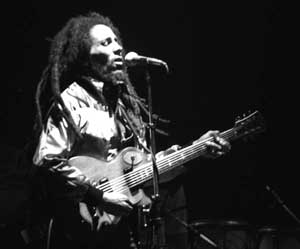Kazim Al-Saher — A lot of people outside the middle east have never heard of this man, but he’s so famous in that region that he’s been called the “Caesar of Arabic song.” He may be one of the best selling singers in the history of the Arabic world! Maybe. That’s a pretty strong statement, but maybe! Kazim is an Iraqi, and a graduate of the Baghdad Institute of Music. I believe he lived in Egypt during the recent war, but was recently very enthusiastically welcomed on a humanitarian trip home to Iraq. He has a beautiful voice. Click here.
 Mamak Khadem — Inspired by Persian poetry to become a singer, this woman has a voice that absolutely soars. She was born in Iran where she sang from the time she was a child, and she later studied classical Indian singing as well. Her songs always sound as though she’s singing them in a trance. Here she is singing live. Click here.
Mamak Khadem — Inspired by Persian poetry to become a singer, this woman has a voice that absolutely soars. She was born in Iran where she sang from the time she was a child, and she later studied classical Indian singing as well. Her songs always sound as though she’s singing them in a trance. Here she is singing live. Click here.
And here’s one of my favorite songs in my music collection, sung while she was part of a group called Axiom of Choice. It’s called “Parvaz” or “Flight” and you definitely feel like you’re floating on the wind when you listen to it. Click here.
 Flight of the Conchords — This is just for fun! This is a pair of friends in New Zealand who call themselves Flight of the Conchords, and sing comedic folk songs together. They became an absolute cult sensation in many countries across the world, particularly among sarcastic young adults. They even had a television series on HBO for a while. I’m not sure what they’re up to these days, but a few years ago, this duo and this video was a bit of a rage. It’s comedy, but a lot of creativity goes into the musicality of their songs as well! Click here.
Flight of the Conchords — This is just for fun! This is a pair of friends in New Zealand who call themselves Flight of the Conchords, and sing comedic folk songs together. They became an absolute cult sensation in many countries across the world, particularly among sarcastic young adults. They even had a television series on HBO for a while. I’m not sure what they’re up to these days, but a few years ago, this duo and this video was a bit of a rage. It’s comedy, but a lot of creativity goes into the musicality of their songs as well! Click here.
Top photo: Wikimedia Commons / This work has been released into the public domain by its author, Y.Momani. / Kazim Al-Saher
Second photo: Photo by User Zereshk / Wikimedia Commons / This image (or other media file) is in the public domain because its copyright has expired. / Picture of painting from Hasht-Behesht palace, Isfahan, Iran, from 1669.
Third photo: A. Aruninta / Wikimedia Commons / Permission is granted to copy, distribute and/or modify this document under the terms of the GNU Free Documentation License / Mount cook, New Zealand



























